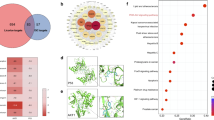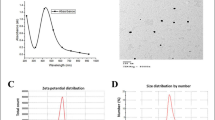Abstract
The clinical use of gentamicin (GM) is restricted by its nephrotoxic effects. This study aimed for the first time to elucidate the ameliorative effects of the monoterpene linalool (Lin) against GM-mediated acute kidney injury in rats. A total of thirty-two rats were subdivided into four equal groups: control (saline), Lin (100 mg/kg/day), GM (100 mg/kg/day), and GM + Lin (100 and 100 mg/kg/day). Lin and GM were intraperitoneally administered for 12 days. Our results illustrated that Lin ameliorated GM-mediated renal histopathological abnormalities and reduced serum urea and creatinine levels in rats exposed to GM. Lin treatment mitigated oxidative stress in nephrotoxic animals as manifested by reducing serum and renal levels of malondialdehyde and increasing the activities of serum and renal glutathione peroxidase and renal catalase. Moreover, Lin markedly inhibited GM-triggered inflammation by downregulating NF-κB, iNOS, TNF-α, and IL-1β and reducing renal myeloperoxidase activity and nitric oxide levels. Interestingly, Lin repressed GM-induced apoptosis, as reflected by a marked downregulation of Bax and caspase-3 expression, concurrent with the upregulation of Bcl2 expression. Finally, Lin administration led to a significant downregulation of TGF-β expression in nephrotoxic animals. In summary, Lin ameliorated GM-mediated nephrotoxicity in rats, at least through its antioxidant, anti-inflammatory, and anti-apoptotic activities and by modulating TGF-β.








Similar content being viewed by others
Data availability
No datasets were generated or analysed during the current study.
References
Abd-Elhamid TH, Elgamal DA, Ali SS et al (2018) Reno-protective effects of ursodeoxycholic acid against gentamicin-induced nephrotoxicity through modulation of NF-κB, eNOS and caspase-3 expressions. Cell Tissue Res 374:367–387. https://doi.org/10.1007/s00441-018-2886-y
Abou-Abbass H, Bahmad H, Abou-El-Hassan H et al (2016) Deciphering glycomics and neuroproteomic alterations in experimental traumatic brain injury: comparative analysis of aspirin and clopidogrel treatment. Electrophoresis 37:1562–1576. https://doi.org/10.1002/elps.201500583
Adil M, Kandhare AD, Dalvi G et al (2016) Ameliorative effect of berberine against gentamicin-induced nephrotoxicity in rats via attenuation of oxidative stress, inflammation, apoptosis and mitochondrial dysfunction. Ren Fail 38:996–1006. https://doi.org/10.3109/0886022X.2016.1165120
Albalawi RS, Binmahfouz LS, Hareeri RH et al (2023) Parthenolide phytosomes attenuated gentamicin-induced nephrotoxicity in rats via activation of Sirt-1, Nrf2, OH-1, and NQO1 axis. Molecules 28:2741. https://doi.org/10.3390/molecules28062741
Ali F, Hassanein E, Bakr A et al (2020) Ursodeoxycholic acid abrogates gentamicin-induced hepatotoxicity in rats: role of NF-κB-p65/TNF-α, Bax/Bcl-xl/Caspase-3, and eNOS/iNOS pathways. Life Sci 254:117760. https://doi.org/10.1016/j.lfs.2020.117760
Altinoz E, Oner Z, Elbe H et al (2022) Linalool exhibits therapeutic and protective effects in a rat model of doxorubicin-induced kidney injury by modulating oxidative stress. Drug Chem Toxicol 45:2024–2030. https://doi.org/10.1080/01480545.2021.1894751
Altlnok-Yipel F, Tekeli IO, Özsoy OY et al (2020) Hepatoprotective activity of linalool in rats against liver injury induced by carbon tetrachloride. Int J Vitam Nutr Res 90:302–308. https://doi.org/10.1024/0300-9831/A000581
Araujo M, Welch WJ (2006) Oxidative stress and nitric oxide in kidney function. Curr Opin Nephrol Hypertens 15:72–77. https://doi.org/10.1097/01.mnh.0000191912.65281.e9
Azırak S, Özgöçmen M (2023) Linalool prevents kidney damage by inhibiting rifampicin-induced oxidative stress and apoptosis. Tissue Cell 82:102097. https://doi.org/10.1016/j.tice.2023.102097
Babaeenezhad E, Dezfoulian O, Hadipour Moradi F et al (2023) Exogenous glutathione protects against gentamicin-induced acute kidney injury by inhibiting NF-κB pathway, oxidative stress, and apoptosis and regulating PCNA. Drug Chem Toxicol 46:441–450. https://doi.org/10.1080/01480545.2022.2049290
Bae EH, Kim IJ, Joo SY et al (2014) Renoprotective effects of the direct renin inhibitor aliskiren on gentamicin-induced nephrotoxicity in rats. J Renin-Angiotensin-Aldosterone Syst 15:348–361. https://doi.org/10.1177/1470320312474853
Beshay ON, Ewees MG, Abdel-Bakky MS et al (2020) Resveratrol reduces gentamicin-induced EMT in the kidney via inhibition of reactive oxygen species and involving TGF-β/Smad pathway. Life Sci 258:118178. https://doi.org/10.1016/j.lfs.2020.118178
Bickers D, Calow P, Greim H et al (2003) A toxicologic and dermatologic assessment of linalool and related esters when used as fragrance ingredients. Food Chem Toxicol 41:919–942. https://doi.org/10.1016/S0278-6915(03)00016-4
Christo JS, Rodrigues AM, Mouro MG et al (2011) Nitric oxide (NO) is associated with gentamicin (GENTA) nephrotoxicity and the renal function recovery after suspension of GENTA treatment in rats. Nitric Oxide 24:77–83. https://doi.org/10.1016/j.niox.2010.12.001
Deepa B, Anuradha CV (2013) Effects of linalool on inflammation, matrix accumulation and podocyte loss in kidney of streptozotocin-induced diabetic rats. Toxicol Mech Methods 23:223–234. https://doi.org/10.3109/15376516.2012.743638
DiRenzo DM, Chaudhary MA, Shi X et al (2016) A crosstalk between TGF-β/Smad3 and Wnt/β-catenin pathways promotes vascular smooth muscle cell proliferation. Cell Signal 28:498–505. https://doi.org/10.1016/j.cellsig.2016.02.011
Dursun M, Sahin S, Besiroglu H et al (2018) Protective effect of nebivolol on gentamicin-induced nephrotoxicity in rats. Bratisl Med J 119:718–725. https://doi.org/10.4149/BLL_2018_128
El-Kashef DH, El-Kenawi AE, Suddek GM, Salem HA (2015) Protective effect of allicin against gentamicin-induced nephrotoxicity in rats. Int Immunopharmacol 29:679–686. https://doi.org/10.1016/j.intimp.2015.09.010
Ellman GL (1959) Tissue sulfhydryl groups. Arch Biochem Biophys 82:70–77. https://doi.org/10.1016/0003-9861(59)90090-6
Giustarini D, Rossi R, Milzani A, Dalle-Donne I (2008) Nitrite and nitrate measurement by Griess reagent in human plasma: evaluation of interferences and standardization. Methods Enzymol 440:361–380
Gunaseelan S, Balupillai A, Govindasamy K et al (2017) Linalool prevents oxidative stress activated protein kinases in single UVB-exposed human skin cells. PLoS ONE 12:e0176699. https://doi.org/10.1371/journal.pone.0176699
Hosseini A, Pourheidar E, Rajabian A et al (2023) Linalool attenuated ischemic injury in PC12 cells through inhibition of caspase-3 and caspase-9 during apoptosis. Food Sci Nutr 11:249–260. https://doi.org/10.1002/fsn3.3057
Huang H, Jin WW, Huang M et al (2020) Gentamicin-induced acute kidney injury in an animal model involves programmed necrosis of the collecting duct. J Am Soc Nephrol 31:2097–2115. https://doi.org/10.1681/ASN.2019020204
Huo M, Cui X, Xue J et al (2013) Anti-inflammatory effects of linalool in RAW 264.7 macrophages and lipopolysaccharide-induced lung injury model. J Surg Res 180:e47–e54. https://doi.org/10.1016/J.JSS.2012.10.050
Kang C, Lee H, Hah DY et al (2013) Protective effects of Houttuynia cordata Thunb. On gentamicin-induced oxidative stress and nephrotoxicity in rats. Toxicol Res 29:61–67. https://doi.org/10.5487/TR.2013.29.1.061
Khan SA, Priyamvada S, Farooq N et al (2009) Protective effect of green tea extract on gentamicin-induced nephrotoxicity and oxidative damage in rat kidney. Pharmacol Res 59:254–262. https://doi.org/10.1016/J.PHRS.2008.12.009
Kim MG, Kim SM, Min JH et al (2019) Anti-inflammatory effects of linalool on ovalbumin-induced pulmonary inflammation. Int Immunopharmacol 74:105706. https://doi.org/10.1016/j.intimp.2019.105706
Lee IC, Kim SH, Lee SM et al (2012) Melatonin attenuates gentamicin-induced nephrotoxicity and oxidative stress in rats. Arch Toxicol 86:1527–1536. https://doi.org/10.1007/s00204-012-0849-8
Lee KE, Kim EY, Kim CS et al (2013) Macrophage-stimulating protein attenuates gentamicin-induced inflammation and apoptosis in human renal proximal tubular epithelial cells. Biochem Biophys Res Commun 434:527–533. https://doi.org/10.1016/j.bbrc.2013.03.108
Lopez-Novoa JM, Quiros Y, Vicente L et al (2011) New insights into the mechanism of aminoglycoside nephrotoxicity: an integrative point of view. Kidney Int 79:33–45
Ma J, Xu H, Wu J et al (2015) Linalool inhibits cigarette smoke-induced lung inflammation by inhibiting NF-κB activation. Int Immunopharmacol 29:708–713. https://doi.org/10.1016/J.INTIMP.2015.09.005
Mączka W, Duda-Madej A, Grabarczyk M, Wińska K (2022) Natural compounds in the battle against Microorganisms—Linalool. Molecules 27:6928. https://doi.org/10.3390/molecules27206928
Medić B, Stojanović M, Rovčanin B et al (2019) Pioglitazone attenuates kidney injury in an experimental model of gentamicin-induced nephrotoxicity in rats. Sci Rep 9:13689. https://doi.org/10.1038/s41598-019-49835-1
Mohamed ME, Abduldaium YS, Younis NS (2020) Ameliorative effect of linalool in cisplatin-induced nephrotoxicity: the role of HMGB1/TLR4/NF-κB and NRF2/HO1 pathways. Biomolecules 10:1488. https://doi.org/10.3390/biom10111488
Mohamed ME, Abduldaium MS, Younis NS (2021) Cardioprotective effect of linalool against isoproterenol-induced myocardial infarction. Life 11:120. https://doi.org/10.3390/life11020120
Morales AI, Detaille D, Prieto M et al (2010) Metformin prevents experimental gentamicin-induced nephropathy by a mitochondria-dependent pathway. Kidney Int 77:861–869. https://doi.org/10.1038/KI.2010.11
Mullane K (1989) Neutrophil-platelet interactions and post-ischemic myocardial injury. Prog Clin Biol Res 301:39–51
Ohkawa H, Ohishi N, Yagi K (1979) Assay for lipid peroxides in animal tissues by thiobarbituric acid reaction. Anal Biochem 95:351–358. https://doi.org/10.1016/0003-2697(79)90738-3
Ozbek E, Cekmen M, Ilbey YO et al (2009) Atorvastatin prevents gentamicin-induced renal damage in rats through the inhibition of p38-MAPK and NF-kappaB pathways. Ren Fail 31:382–392. https://doi.org/10.1080/08860220902835863
Öztopuz Ö, Türkön H, Sehitoglu MH et al (2019) Hyperbaric oxygen treatment ameliorates gentamicin-induced nephrotoxicity and expression of kidney injury molecule 1 in the rat model. Undersea Hyperb Med 46:125–133
Politano VT, Lewis EM, Hoberman AM et al (2008) Evaluation of the developmental toxicity of linalool in rats. Int J Toxicol 27:183–188. https://doi.org/10.1080/10915810801977948
Radermacher J, Klanke B, Schurek HJ et al (1992) Importance of NO/EDRF for glomerular and tubular function: studies in the isolated perfused rat kidney. Kidney Int 41:1549–1559. https://doi.org/10.1038/ki.1992.225
Rotruck JT, Pope AL, Ganther HE et al (1973) Selenium: biochemical role as a component of glatathione peroxidase. Science 179:588–590. https://doi.org/10.1126/science.179.4073.588
Sabogal-guáqueta AM, Hobbie F, Keerthi A et al (2019) Linalool attenuates oxidative stress and mitochondrial dysfunction mediated by glutamate and NMDA toxicity. Biomed Pharmacother 118:109295. https://doi.org/10.1016/j.biopha.2019.109295
Salimi A, Khodaparast F, Bohlooli S et al (2022) Linalool reverses benzene-induced cytotoxicity, oxidative stress and lysosomal/mitochondrial damages in human lymphocytes. Drug Chem Toxicol 45:2454–2462. https://doi.org/10.1080/01480545.2021.1957563
Sinha AK (1972) Colorimetric assay of catalase. Anal Biochem 47:389–394. https://doi.org/10.1016/0003-2697(72)90132-7
Song Y, Peng C, Lv S et al (2017) Adipose-derived stem cells ameliorate renal interstitial fibrosis through inhibition of EMT and inflammatory response via TGF-β1 signaling pathway. Int Immunopharmacol 44:115–122. https://doi.org/10.1016/j.intimp.2017.01.008
Srisung W, Teerakanok J, Tantrachoti P et al (2017) Surgical prophylaxis with gentamicin and acute kidney injury: a systematic review and meta-analysis. Ann Transl Med 5:100. https://doi.org/10.21037/atm.2017.03.06
Tavafi M, Ahmadvand H (2011) Effect of rosmarinic acid on inhibition of gentamicin induced nephrotoxicity in rats. Tissue Cell 43:392–397. https://doi.org/10.1016/j.tice.2011.09.001
Tavafi M, Ahmadvand H, Toolabi P (2012) Inhibitory effect of olive leaf extract on gentamicin-induced nephrotoxicity in rats. Iran J Kidney Dis 6:25–32
Tomşa AM, Răchişan AL, Pandrea SL et al (2023) Curcumin and vitamin C attenuate gentamicin-induced nephrotoxicity by modulating distinctive reactive species. Metabolites 13:49. https://doi.org/10.3390/metabo13010049
Yue L, Yang YR, Ma WX et al (2022) Epigallocatechin gallate attenuates gentamicin-induced nephrotoxicity by suppressing apoptosis and ferroptosis. Molecules 27:8564. https://doi.org/10.3390/molecules27238564
Acknowledgements
We would like to thank the Nutritional Health Research Center of Lorestan Medical University, Lorestan, Iran.
Funding
The authors declare that no funds, grants, or other support were received during the preparation of this manuscript.
Author information
Authors and Affiliations
Contributions
EB, OD, MMS, and HA conceived and designed research. EB and OD conducted experiments. MMS and HA contributed new reagents or analytical tools. EB wrote the manuscript. All authors read and approved the manuscript. The authors declare that all data were generated in-house and that no paper mill was used.
Corresponding authors
Ethics declarations
Competing interests
The authors have no relevant financial or non-financial interests to disclose.
Ethics approval
This study was performed in line with the principles of the Declaration of Helsinki. Approval was granted by the Ethics Committee of Lorestan University of Medical Sciences (IR.LUMS.REC.1397.063) and Faculty of Veterinary Medicine, Lorestan University (lu.acri.2023.64).
Consent to participate
Not applicable.
Consent to publication
Not applicable.
Additional information
Publisher’s Note
Springer Nature remains neutral with regard to jurisdictional claims in published maps and institutional affiliations.
Rights and permissions
Springer Nature or its licensor (e.g. a society or other partner) holds exclusive rights to this article under a publishing agreement with the author(s) or other rightsholder(s); author self-archiving of the accepted manuscript version of this article is solely governed by the terms of such publishing agreement and applicable law.
About this article
Cite this article
Babaeenezhad, E., Dezfoulian, O., Moradi Sarabi, M. et al. Monoterpene linalool restrains gentamicin-mediated acute kidney injury in rats by subsiding oxidative stress, apoptosis, and the NF-κB/iNOS/TNF-α/IL-1β pathway and regulating TGF-β. Naunyn-Schmiedeberg's Arch Pharmacol (2024). https://doi.org/10.1007/s00210-024-02978-z
Received:
Accepted:
Published:
DOI: https://doi.org/10.1007/s00210-024-02978-z




